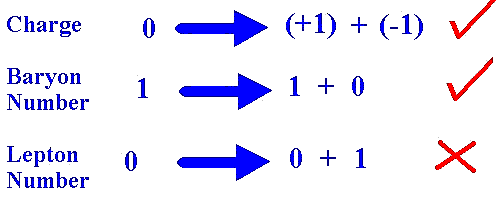    |
||||

Balancing the Equations |
||||
|
It has been discovered that Nature has specific rules for particle interactions and decays, and these rules have been summarized in terms of conservation laws. Conservation of baryon number
All baryons have a baryon number of +1 and all anti-baryons a baryon number of -1 Conservation of lepton numberThis rule is a little more complicated than the conservation of baryon number because there is a separate requirement for each of the three sets of leptons, the electron, muon (a heavy electron!) and tau (not on the syllabus - even heavier than the muon!) and their associated neutrinos... each type of lepton has to be conserved. (See here for more background). NB The matter lepton is negative and its antiparticle positive! A lepton number of 1 is assigned to the electron and the electron neutrino and -1 to the positron electron antineutrino Each class of leptons has a lepton number of +1 and its anti-leptons a lepton number of -1 Remember from GCSE that when b-decay occurs a neutron changes into a proton inside the nucleus.


If we amend the equation we get: 
Now check your results against the Feynman diagrams of those events.. |
||||
 |
||||


